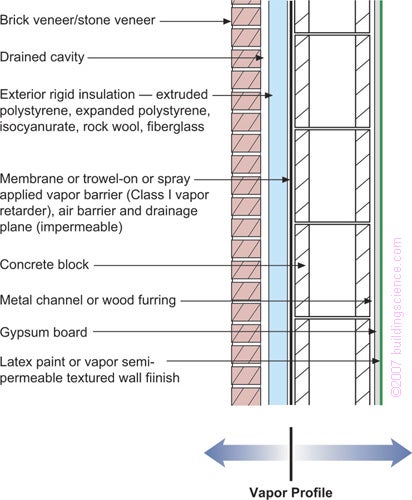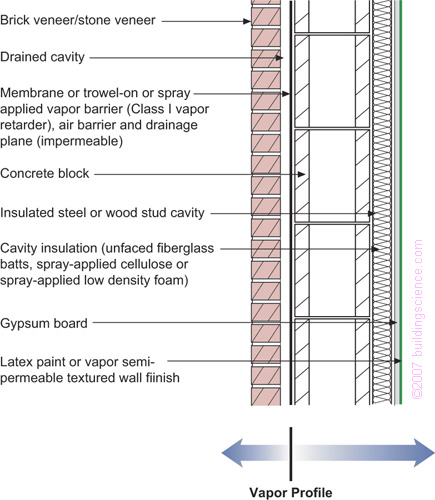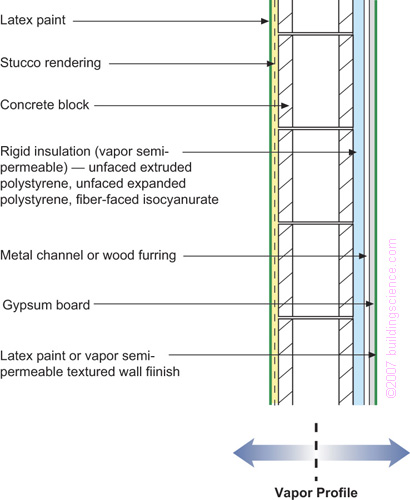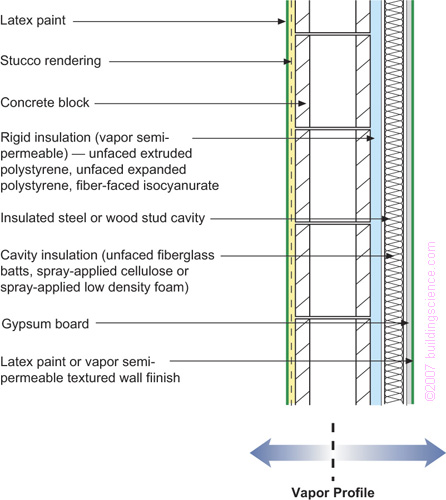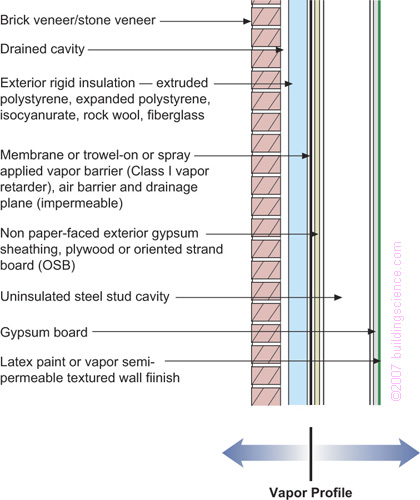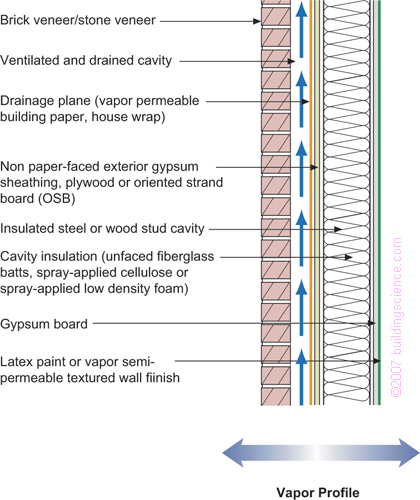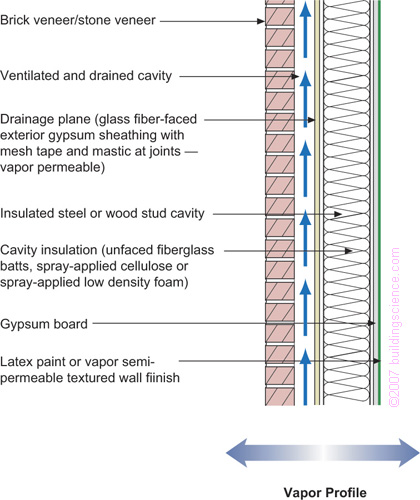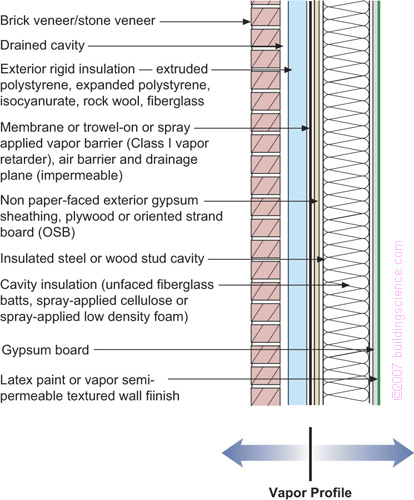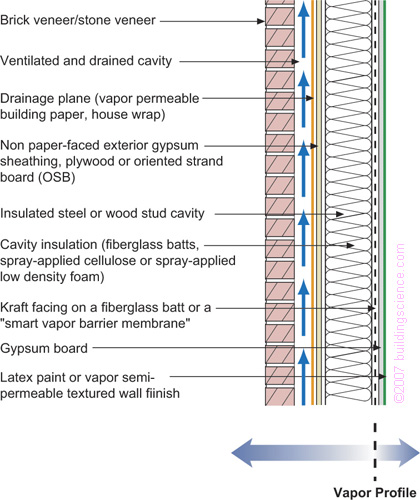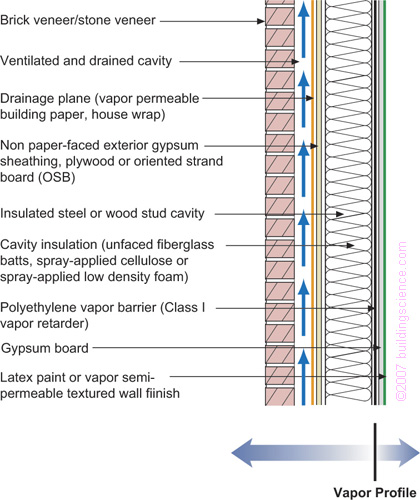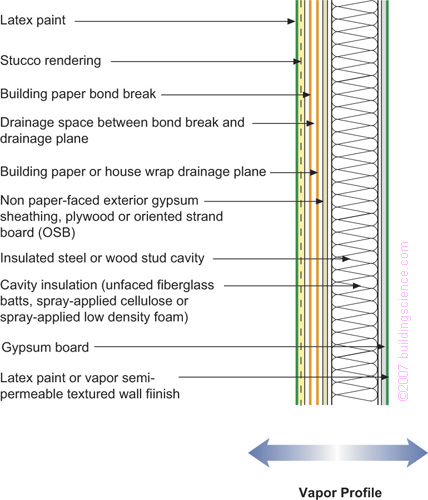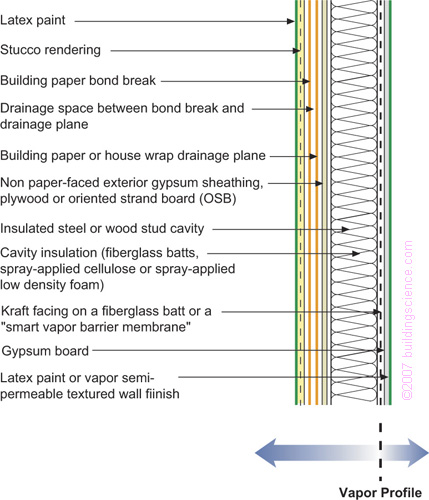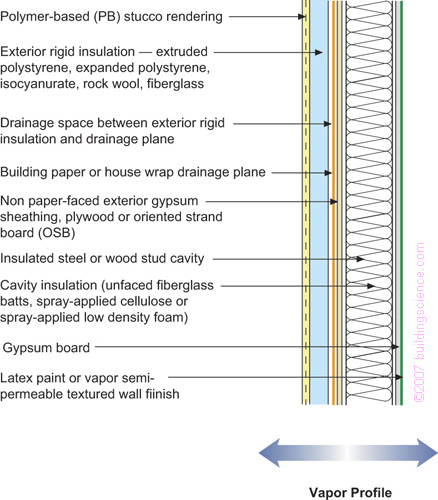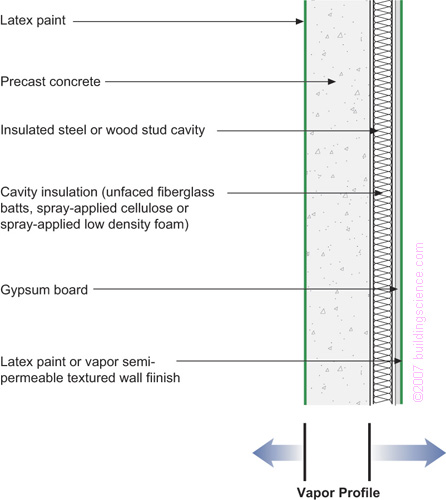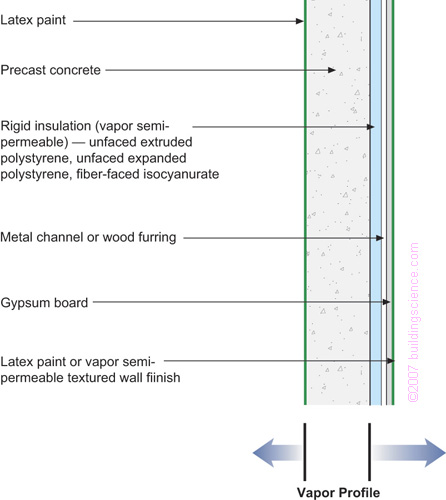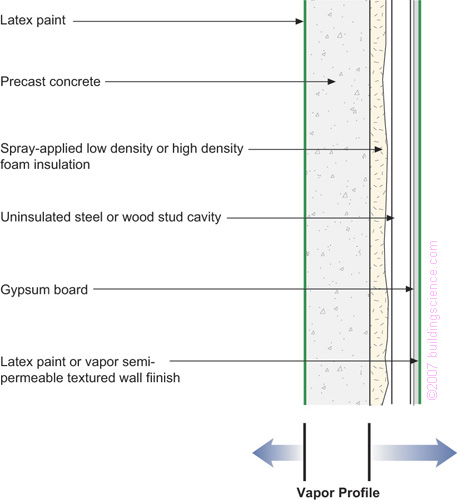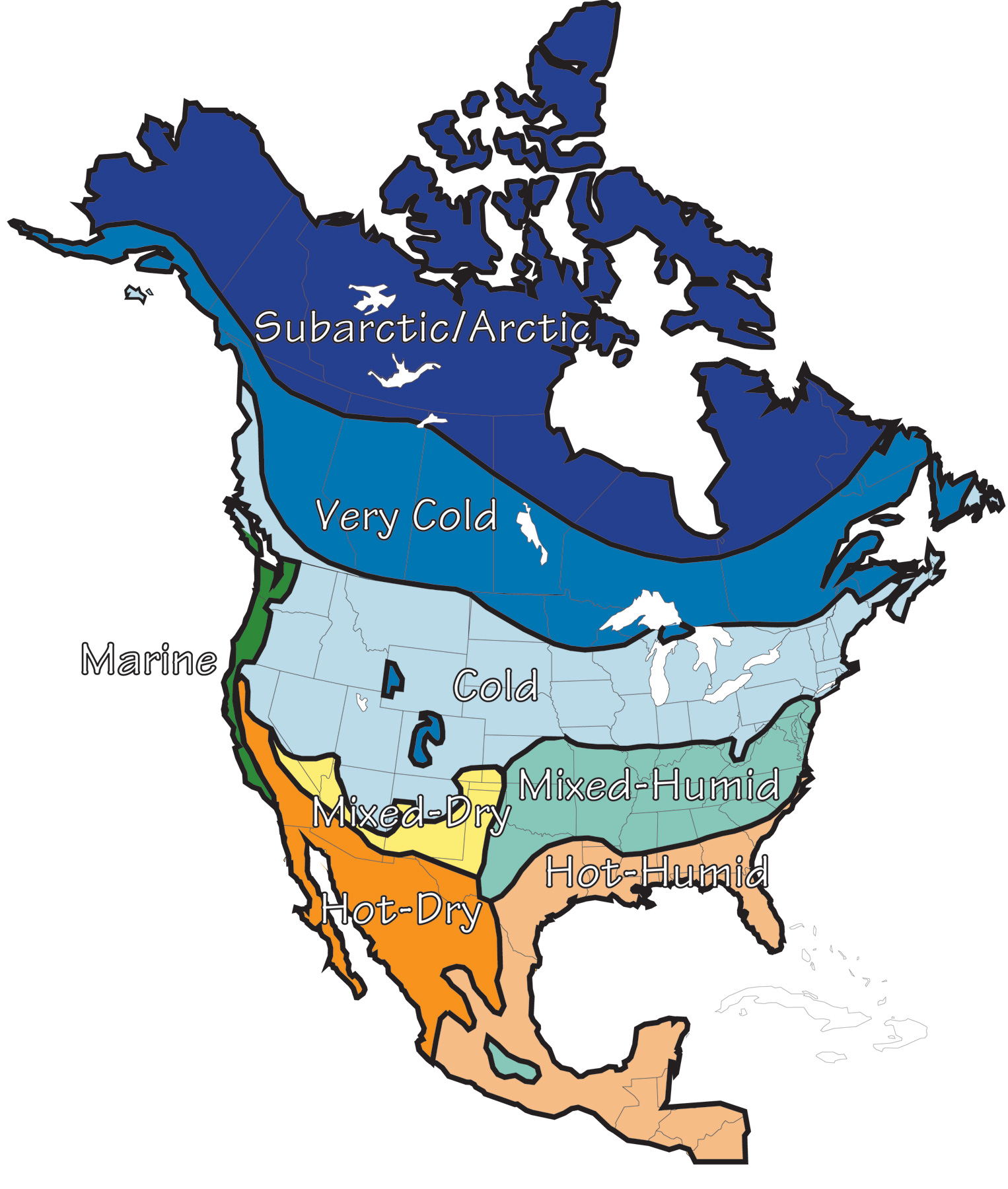The function of a vapor barrier is to retard the migration of water vapor. Where it is located in an assembly and its permeability is a function of climate, the characteristics of the materials that comprise the assembly and the interior conditions. Vapor barriers are not typically intended to retard the migration of air. That is the function of air barriers.
Confusion on the issue of vapor barriers and air barriers is common. The confusion arises because air often holds a great deal of moisture in the vapor form. When this air moves from location to location due to an air pressure difference, the vapor moves with it. This is a type of migration of water vapor. In the strictest sense air barriers are also vapor barriers when they control the transport of moisture-laden air.
An excellent discussion about the differences between vapor barriers and air barriers can be found in Quirrouette (1985).
Vapor barriers are also a cold climate artifact that have diffused into other climates more from ignorance than need. The history of cold climate vapor barriers itself is a story based more on personalities than physics. Rose (1997) regales readers of this history. It is frightening indeed that construction practices can be so dramatically influenced by so little research and reassuring indeed that the inherent robustness of most building assemblies has been able to tolerate such foolishness.
So What is The Problem?
Incorrect use of vapor barriers is leading to an increase in moisture related problems. Vapor barriers were originally intended to prevent assemblies from getting wet. However, they often prevent assemblies from drying. Vapor barriers installed on the interior of assemblies prevent assemblies from drying inward. This can be a problem in any air-conditioned enclosure. This can be a problem in any below grade space. This can be a problem when there is also a vapor barrier on the exterior. This can be a problem where brick is installed over building paper and vapor permeable sheathing.
What Do We Really Want to Do?
Two seemingly simple requirements for building enclosures bedevil engineers and architects almost endlessly:
- keep water out
- let water out if it gets in
Water can come in several phases: liquid, solid, vapor and adsorbed. The liquid phase as rain and ground water has driven everyone crazy for hundreds of years but can be readily understood - drain everything and remember the humble flashing. The solid phase also drives everyone crazy when we have to shovel it or melt it, but at least most professionals understand the related building problems (ice damming, frost heave, freeze-thaw damage). But the vapor phase is in a class of craziness all by itself. We will conveniently ignore the adsorbed phase and leave it for someone else to deal with. Note that adsorbed water is different than absorbed water (see Kumaran, Mitalas & Bomberg, 1994).
The fundamental principle of control of water in the liquid form is to drain it out if it gets in – and let us make it perfectly clear – it will get in if you build where it rains or if you put your building in the ground where there is water in the ground. This is easy to understand, logical, with a long historical basis.
The fundamental principle of control of water in the solid form is to not let it get solid and if it does – give it space or if it is solid not let it get liquid and if it does drain it away before it can get solid again. This is a little more difficult to understand, but logical and based on solid research. Examples of this principle include the use of air entrained concrete to control freeze-thaw damage and the use of attic venting to provide cold roof decks to control ice damming.
The fundamental principle of control of water in the vapor form is to keep it out and to let it out if it gets in. Simple right? No chance. It gets complicated because sometimes the best strategies to keep water vapor out also trap water vapor in. This can be a real problem if the assemblies start out wet because of rain or the use of wet materials.
It gets even more complicated because of climate. In general water vapor moves from the warm side of building assemblies to the cold side of building assemblies. This is simple to understand, except we have trouble deciding what side of a wall is the cold or warm side. Logically, this means we need different strategies for different climates. We also have to take into account differences between summer and winter.
Finally, complications arise when materials can store water. This can be both good and bad. A cladding system such as a brick veneer can act as a reservoir after a rainstorm and significantly complicate wall design. Alternatively, wood framing or masonry can act as a hygric buffer absorbing water lessening moisture shocks.
What is required is to define vapor control measures on a more regional climatic basis and to define the vapor control measures more precisely.
Part of the problem is that we struggle with names and terms. We have vapor retarders, we have vapor barriers, we have vapor permeable we have vapor impermeable, etc. What do these terms mean? It depends on whom you ask and whether they are selling something or arguing with a building official. In an attempt to clear up some of the confusion the following definitions are proposed:
Vapor Retarder*: The element that is designed and installed in an assembly to retard the movement of water by vapor diffusion.
* taken somewhat from ASHRAE Fundamentals 2001, Chapter 23.
The unit of measurement typically used in characterizing the water vapor permeance of materials is the “perm.” It is further proposed here that there should be several classes of vapor retarders (this is nothing new – it is an extension and modification of the Canadian General Standards Board approach that specifies Type I and Type II vapor retarders – the numbers here are a little different however):
|
Class I Vapor Retarder: |
0.1 perm or less |
|
Class II Vapor Retarder: |
1.0 perm or less and greater than 0.1 perm |
|
Class III Vapor Retarder |
10 perm or less and greater than 1.0 perm |
|
|
|
|
Test Procedure for vapor retarders: |
ASTM E-96 Test Method A (the desiccant method or dry cup method) |
Finally, a vapor barrier is defined as:
Vapor Barrier: A Class I vapor retarder.
The current International Building Code (and its derivative codes) defines a vapor retarder as 1.0 perm or less (using the same test procedure). In other words the current code definition of a vapor retarder is equivalent to the definition of a Class II Vapor Retarder proposed by the author.
Continuing in the spirit of finally defining terms that are tossed around in the enclosure business. It is also proposed that materials be separated into four general classes based on their permeance (again nothing new, this is an extension of the discussion in ASHRAE Journal, February 02 – Moisture Control for Buildings):
|
Vapor impermeable |
0.1 perm or less |
|
Vapor semi-impermeable |
1.0 perm or less and greater than 0.1 perm |
|
Vapor semi-permeable: |
10 perms or less and greater than 1.0 perm |
|
Vapor permeable: |
greater than 10 perms |
Recommendations for Building Enclosures
The following building assembly recommendations are climatically based (see Side Bar 1) and are sensitive to cladding type (brick or stone veneer, stucco) and structure (concrete block, steel or wood frame, precast concrete).
The recommendations apply to residential, business, assembly, and educational and mercantile occupancies. The recommendations do not apply to special use enclosures such as spas, pool buildings, museums, hospitals, data processing centers or other engineered enclosures such as factory, storage or utility enclosures.
The recommendations are based on the following principles:
-
Avoidance of using vapor barriers where vapor retarders will provide satisfactory performance. Avoidance of using vapor retarders where vapor permeable materials will provide satisfactory performance. Thereby encouraging drying mechanisms over wetting prevention mechanisms.
-
Avoidance of the installation of vapor barriers on both sides of assemblies – i.e. “double vapor barriers” in order to facilitate assembly drying in at least one direction.
-
Avoidance of the installation of vapor barriers such as polyethylene vapor barriers, foil faced batt insulation and reflective radiant barrier foil insulation on the interior of air-conditioned assemblies – a practice that has been linked with moldy buildings (Lstiburek, 2002).
-
Avoidance of the installation of vinyl wall coverings on the inside of air-conditioned assemblies – a practice that has been linked with moldy buildings (Lstiburek, 1993).
-
Enclosures are ventilated meeting ASHRAE Standard 62.2 or 62.1.
Each of the recommended building assemblies were evaluated using dynamic hygrothermal modeling. The moisture content of building materials that comprise the building assemblies all remained below the equilibrium moisture content of the materials as specified in ASHRAE 160 P under this evaluation approach. Interior air conditions and exterior air conditions as specified by ASHRAE 160 P were used. WUFI was used as the modeling program (Kunzel, 1999).
More significantly, each of the recommended building assemblies have been found by the author to provide satisfactory performance under the limitations noted. Satisfactory performance is defined as no moisture problems reported or observed over at least a 10-year period.
Applicability – Limited to mixed-humid, hot-humid, mixed-dry, hot-dry and marine regions – should not be used in cold, very cold, and subarctic/arctic regions
This wall assembly has all of the thermal insulation installed to the interior of the vapor barrier and therefore should not be used in cold regions or colder. It is also a durable assembly due to the block construction and the associated moisture storage (hygric buffer) capacity. The wall assembly does contain water sensitive cavity insulation (except where spray foam is used) and it is important that this assembly can dry inwards – therefore vapor semi impermeable interior finishes such as vinyl wall coverings should be avoided. In this wall assembly the vapor barrier is also the drainage plane and air barrier.
Figure 3: Concrete Block With Interior Rigid Insulation and Stucco
Applicability – all hygro-thermal regions*
This assembly has all of the thermal insulation installed on the interior of the concrete block construction but differs from Figure 2 since it does not have a vapor barrier on the exterior. The assembly also does not have a vapor barrier on the interior of the assembly. It has a large moisture storage (hygric buffer) capacity due to the block construction. The rigid insulation installed on the interior should ideally be non-moisture sensitive and allow the wall to dry inwards – hence the recommended use of vapor semi permeable foam sheathing. Note that foam sheathing faced with aluminum foil or polypropylene skins would also be acceptable provided only non-moisture sensitive materials are used at the masonry block to insulation interface. It is important that this assembly inboard of the foam sheathing can dry inwards except in very cold and subarctic/arctic regions – therefore vapor semi impermeable interior finishes such as vinyl wall coverings should be avoided in assemblies – except in very cold and subarctic/arctic regions. Vapor impermeable foam sheathings should be used in place of the vapor semi permeable foam sheathings in very cold and subarctic/arctic regions. The drainage plane in this assembly is the latex painted stucco rendering. A Class III vapor retarder is located on both the interior and exterior of the assembly (the latex paint on the stucco and on the interior gypsum board).
* In very cold and subarctic/arctic regions vapor impermeable foam sheathings are recommended
This assembly is a variation of Figure 3. It also has all of the thermal insulation installed on the interior of the concrete block construction but differs from Figure 3 due to the addition of a frame wall to the interior of the rigid insulation. This assembly also does not have a vapor barrier on the exterior. The assembly also does not have a vapor barrier on the interior of the assembly. It has a large moisture storage (hygric buffer) capacity due to the block construction. The rigid insulation installed on the interior should ideally be non-moisture sensitive and allow the wall to dry inwards — hence the recommended use of vapor semi permeable foam sheathing. Note that foam sheathing faced with aluminum foil or polypropylene skins would also be acceptable provided only non-moisture sensitive materials are used at the masonry block to insulation interface. It is important that this assembly inboard of the rigid insulation can dry inwards even in very cold and subarctic/arctic regions — therefore vapor semi impermeable interior finished such as vinyl wall coverings should be avoided in assemblies. Vapor impermeable foam sheathings should be used in place of the vapor semi permeable foam sheathings in very cold and subarctic/arctic regions. The drainage plane in this assembly is the latex painted stucco rendering. A Class III vapor retarder is located on both the interior and exterior of the assembly (the latex paint on the stucco and on the interior gypsum board).
* In very cold and sub arctic/arctic regions vapor impermeable foam sheathings are recommended – additionally the thickness of the foam sheathing should be determined by hygro-thermal analysis so that the interior surface of the foam sheathing remains above the dew point temperature of the interior air (see Side Bar 2).
Figure 5: Frame Wall With Exterior Insulation and Brick or Stone Veneer
Applicability – all hygro-thermal regions
This wall is a variation of Figure 1 – but without the moisture storage (or hygric buffer) capacity. This wall is also a durable wall assembly. It is constructed from non-water sensitive materials and has a high drying potential inwards due to the frame wall cavity not being insulated. It can also be constructed virtually anywhere. In cold climates condensation is limited on the interior side of the vapor barrier as a result of installing all of the thermal insulation on the exterior side of the vapor barrier (which is also the drainage plane and air barrier in this assembly). In hot climates any moisture that condenses on the exterior side of the vapor barrier will be drained to the exterior since the vapor barrier is also a drainage plane. This wall assembly will dry from the vapor barrier inwards and will dry from the vapor barrier outwards.
Figure 6: Frame Wall With Cavity Insulation and Brick or Stone Veneer
Applicability – Limited to mixed-humid, hot-humid, mixed-dry, hot-dry and marine regions – can be used with hygro-thermal analysis in some areas in cold regions (Zone 5, but not Zone 6; see Side Bar 2)- should not be used in very cold and subarctic/arctic regions
This wall is a flow through assembly – it can dry to both the exterior and the interior. It has a Class III vapor retarder on the interior of the assembly (the latex paint on the gypsum board). It is critical in this wall assembly that the exterior brick veneer (a “reservoir” cladding) be uncoupled from the wall assembly with a ventilated and drained cavity. The cavity behind the brick veneer should be at least 2 inches wide (source: Brick Institute of America) and free from mortar droppings. It must also have air inlets (“weep holes”) at its base and air outlets (“weep holes”) at its top in order to provide back ventilation of the brick veneer. The drainage plane in this assembly is the building paper or building wrap. The air barrier can be any of the following: the interior gypsum board, the exterior gypsum wallboard or the exterior building wrap.
Figure 7: Frame Wall With Cavity Insulation and Brick or Stone Veneer
Applicability – Limited to mixed-humid, hot-humid, mixed-dry, hot-dry and marine regions – can be used with hygro-thermal analysis in some areas in cold regions (Zone 5, but not Zone 6; see Side Bar 2)- should not be used in very cold and subarctic/arctic regions
This wall is a variation of Figure 6. The exterior gypsum sheathing becomes the drainage plane. As in Figure 6 this wall is a flow through assembly – it can dry to both the exterior and the interior. It has a Class III vapor retarder on the interior of the assembly (the latex paint on the gypsum board). It is also critical in this wall assembly that the exterior brick veneer (a “reservoir” cladding) be uncoupled from the wall assembly with a ventilated and drained cavity. The cavity behind the brick veneer should be at least 2 inches wide (source: Brick Institute of America) and free from mortar droppings. It must also have air inlets (“weep holes”) at its base and air outlets (“weep holes”) at its top in order to provide back ventilation of the brick veneer. The air barrier in this assembly can be either the interior gypsum board or the exterior gypsum sheathing.
Figure 8: Frame Wall With Exterior Rigid Insulation With Cavity Insulation and Brick or Stone Veneer
Applicability – all hygro-thermal regions except subarctic/arctic – in cold and very cold regions the thickness of the foam sheathing should be determined by hygro-thermal analysis so that the interior surface of the foam sheathing remains above the dew point temperature of the interior air (see Side Bar 2)
This wall is a variation of Figure 5. In cold climates condensation is limited on the interior side of the vapor barrier as a result of installing some of the thermal insulation on the exterior side of the vapor barrier (which is also the drainage plane and air barrier in this assembly). In hot climates any moisture that condenses on the exterior side of the vapor barrier will be drained to the exterior since the vapor barrier is also a drainage plane. This wall assembly will dry from the vapor barrier inwards and will dry from the vapor barrier outwards. Since this wall assembly has a vapor barrier that is also a drainage plane it is not necessary to back vent the brick veneer reservoir cladding as in Figure 6 and Figure 7. Moisture driven inwards out of the brick veneer will condense on the vapor barrier/drainage plane and be drained outwards.
Figure 9: Frame Wall With Cavity Insulation and Brick or Stone Veneer With Interior Vapor Retarder
Applicability – Limited to cold and very cold regions
This wall is a variation of Figure 6 except it has a Class II vapor retarder on the interior limiting its inward drying potential – but not eliminating it. It still considered a flow through assembly – it can dry to both the exterior and the interior. It is critical in this wall assembly – as in Figure 6 and Figure 7 - that the exterior brick veneer (a “reservoir” cladding) be uncoupled from the wall assembly with a ventilated and drained cavity. The cavity behind the brick veneer should be at least 2 inches wide (source: Brick Institute of America) and free from mortar droppings. It must also have air inlets (“weep holes”) at its base and air outlets (“weep holes”) at its top in order to provide back ventilation of the brick veneer. The drainage plane in this assembly is the building paper or building wrap. The air barrier can be any of the following: the interior gypsum board, the exterior gypsum board or the exterior building wrap.
Figure 10: Frame Wall With Cavity Insulation and Brick or Stone Veneer With Interior Vapor Barrier
Applicability – Limited to very cold, subarctic and arctic regions
This wall is a further variation of Figure 6 but now it has a Class I vapor retarder on the interior (a “vapor barrier”) completely eliminating any inward drying potential. It is considered the “classic” cold climate wall assembly. It is critical in this wall assembly – as in Figure 6, Figure 7 and Figure 9 - that the exterior brick veneer (a “reservoir” cladding) be uncoupled from the wall assembly with a ventilated and drained cavity. The cavity behind the brick veneer should be at least 2 inches wide (source: Brick Institute of America) and free from mortar droppings. It must also have air inlets at its base and air outlets at its top in order to provide back ventilation of the brick veneer. The drainage plane in this assembly is the building paper or building wrap. The air barrier can be any of the following: the interior polyethylene vapor barrier, the interior gypsum board, the exterior gypsum board or the exterior building wrap.
Figure 11: Frame Wall With Cavity Insulation and Stucco
Applicability – Limited to mixed-humid, hot-humid, mixed-dry, and hot-dry regions should not be used in marine, cold, very cold, and subarctic/arctic regions
This wall is also a flow through assembly similar to Figure 6 – but without the brick veneer – it has a stucco cladding. It can dry to both the exterior and the interior. It has a Class III vapor retarder on the interior of the assembly (the latex paint on the gypsum board). It is critical in this wall assembly that a drainage space be provided between the stucco rendering and the drainage plane. This can be accomplished by installing a bond break (a layer of tar paper) between the drainage plane and the stucco. A spacer mat can also be used to increase drainability. Alternatively, a textured or profiled drainage plane (building wrap) can be used. The drainage plane in this assembly is the building paper or building wrap. The air barrier can be any of the following: the interior gypsum board, the exterior stucco rendering, the exterior sheathing or the exterior building wrap.
Figure 12: Frame Wall With Cavity Insulation and Stucco With Interior Vapor Retarder
Applicability – Limited to marine, cold and very cold regions
This wall is a variation of Figure 6 and Figure 11 except it has a Class II vapor retarder on the interior limiting its inward drying potential – but not eliminating it. It still considered a flow through assembly – it can dry to both the exterior and the interior. It is critical in this wall assembly – as in Figure 11 – that a drainage space be provided between the stucco rendering and the drainage plane. This can be accomplished by installing a bond break (a layer of tar paper) between the drainage plane and the stucco. A spacer mat can also be used to increase drainability. Alternatively, a textured or profiled drainage plane (building wrap) can be used. The drainage plane in this assembly is the building paper or building wrap. The air barrier can be any of the following: the interior gypsum board, the exterior stucco rendering, the exterior sheathing or the exterior building wrap.
Figure 13: Frame Wall With Exterior Rigid Insulation With Cavity Insulation and Stucco
Applicability – all hygro-thermal regions except subarctic/arctic – in cold and very cold regions the thickness of the foam sheathing should be determined by hygro-thermal analysis so that the interior surface of the foam sheathing remains above the dew point temperature of the interior air (see Side Bar 2)
This is a water managed exterior insulation finish system (EIFS). Unlike “face-sealed” EIFS this wall has a drainage plane inboard of the exterior stucco skin that is drained to the exterior. It is also a flow through assembly similar to Figure 6. It can dry to both the exterior and the interior. It has a Class III vapor retarder on the interior of the assembly (the latex paint on the gypsum board). It is critical in this wall assembly that a drainage space be provided between the exterior rigid insulation and the drainage plane. This can be accomplished by installing a spacer mat or by providing drainage channels in the back of the rigid insulation. Alternatively, a textured or profiled drainage plane (building wrap) can be used. The drainage plane in this assembly is the building paper or building wrap. The air barrier can be any of the following: the interior gypsum board, the exterior stucco rendering, the exterior sheathing or the exterior building wrap.
Figure 14: Precast Concrete With Interior Frame Wall Cavity Insulation
Applicability – Limited to mixed-humid, hot-humid, mixed-dry, hot-dry and marine regions – should not be used in cold, very cold, and subarctic/arctic regions
The vapor barrier in this assembly is the precast concrete itself. Therefore this wall assembly has all of the thermal insulation installed to the interior of the vapor barrier. Of particular concern is the fact that the thermal insulation is air permeable (except where spray foam is used). Therefore this wall assembly should not be used in cold regions or colder. It has a small moisture storage (hygric buffer) capacity due to the precast concrete construction. The wall assembly does contain water sensitive cavity insulation (except where spray foam is used) and it is important that this assembly can dry inwards – therefore vapor semi impermeable interior finishes such as vinyl wall coverings should be avoided. In this wall assembly the precast concrete is also the drainage plane and air barrier.
Figure 15: Precast Concrete With Interior Rigid Insulation
Applicability – all hygro-thermal regions*
This assembly has all of the thermal insulation installed on the interior of the precast concrete. The assembly also does not have a vapor barrier on the interior of the assembly. It has a small moistuure storage (hygric buffer) capacity due to the precast concrete construction. The rigid insulation installed on the interior should ideally be non-moisture sensitive and allow the wall to dry inwards — hence the recommended use of vapor semi permeable foam sheathing. Note that foam sheathing faced with aluminum foil or polypropylene skins would also be acceptable provided only non-moisture sensitive materials are used at the concrete to insulation interface. It is important that this assembly inboard of the foam sheathing can dry inwards except in very cold subarctic/arctic regions — therefore vapor semi impermeable interior finishes such as vinyl wall coverings should be avoided in assemblies — except in very cold and subarctic/arctic regions. Vapor impermeable foam sheathings should be used in place of the vapor semi permeable foam sheathings in very cold and subarctic/arctic regions. The drainage plane in this assembly is the latex painted precast concrete. A Class III vapor retarder is located on both the interior and exterior of the assembly (the latex paint on the stucco and on the interior gypsum board).
Figure 16: Precast Concrete With Interior Spray Applied Foam Insulation
Applicability – all hygro-thermal regions*
This assembly has all of the thermal insulation installed on the interior of the precast concrete. The assembly also does not have a vapor barrier on the interior of the assembly. It has a small moisture storage (hygric buffer) capacity due to the precast concrete construction. The spray foam insulation installed on the interior of the precast concrete is non-moisture sensitive and allows the wall to dry inwards. It is important that this assembly can dry inwards except in very cold and subarctic/arctic regions – therefore vapor semi impermeable interior finishes such as vinyl wall coverings should be avoided in assemblies – except in very cold and subarctic/arctic regions. High-density spray foam, due to its vapor semi impermeable characteristics should be used in place of low-density foam in very cold and subarctic/arctic regions. The drainage plane in this assembly is the latex painted precast concrete. A Class III vapor retarder is located on both the interior and exterior of the assembly (the latex paint on the stucco and on the interior gypsum board.
* In very cold and subarctic/arctic regions high-density spray foam (vapor semi impermeable) is recommended
References
Kumaran, M.K., Mitalas, G.P., and Bomberg, M.T.; Fundamentals of Transport and Storage of Moisture in Building Materials and Components; Moisture Control in Buildings, ASTM Manual Series: MNL 18, ASTM Publication Code (PCN) 28-018094-10, Philadelphia, PA, 1994.
Kunzel, H.M.; WUFI: PC Program for Calculating the Coupled Heat and Moisture Transfer in Building Components; Fraunhofer Institute for Building Physics, Holzkirchen, Germany, 1999.
Lstiburek, J.W.; "Humidity Control in the Humid South," Workshop Proceedings – Bugs, Mold & Rot II, BETEC, Washington, November 1993.
Lstiburek, J.W.; "Moisture Control For Buildings;" ASHRAE Journal, February 2002.
Lstiburek, J.W.; "Investigating Diagnosing Moisture Problems," ASHRAE Journal, December 2002.
Quirouette, R.L.; The Difference Between a Vapor Barrier and an Air Barrier; Building Practice Note 54, Division of Building Research, National Research Council of Canada, ISSN 0701-5216, Ottawa, Ontario, Canada, July 1985.
Rose, W.; Moisture Control in the Modern Building Envelope: The History of the Vapor Barrier in the US – 1923 to 1952, APT, Volume XXVIII, Number 4, 1997
Sidebar 1
Hygro-Thermal Regions
Subarctic and Arctic
A subarctic and arctic climate is defined as a region with approximately 12,600 heating degree days (65 degrees F basis) [7,000 heating degree days (18 degrees C basis)] or greater.
Very Cold
A very cold climate is defined as a region with approximately 9,000 heating degree days or greater (65 degrees F basis) [5,000 heating degree days (18 degrees C basis)] or greater and less than 12,600 heating degree days (65 degrees F basis) [7,000 heating degree days (18 degrees C basis)].
Cold
A cold climate is defined as a region with approximately 5,400 heating degree days (65 degrees F basis) [3,000 heating degree days (18 degrees C basis)] or greater and less than approximately 9,000 heating degree days (65 degrees F basis) [5,000 heating degree days (18 degrees C basis)].
Mixed-Humid
A mixed-humid and warm-humid climate is defined as a region that receives more than 20 inches (50 cm) of annual precipitation with approximately 4,500 cooling degree days (50 degrees F basis) [2,500 cooling degree days (10 degrees C basis)] or greater and less than approximately 6,300 cooling degree days (50 degrees F basis) [3,500 cooling degree days (10 degrees C basis)] and less than approximately 5,400 heating degree days (65 degrees F basis) [3,000 heating degree days (18 degrees C basis)] and where the average monthly outdoor temperature drops below 45 degrees F (7 degrees C) during the winter months.
Marine
A marine climate meets is defined as a region where all of the following occur:
-
a mean temperature of the coldest month between 27 degrees F (-3 degrees C) and 65 degrees F (18 degrees C);
-
a mean temperature of the warmest month below 72 degrees F (18 degrees C);
-
at least four months with mean temperatures over 50 degrees F (10 degrees C); and
-
a dry season in the summer, the month with the heaviest precipitation in the cold season has at least three times as much precipitation as the month with the least precipitation.
Hot-Humid
A hot-humid climate is defined as a region that receives more than 20 inches (50 cm) of annual precipitation with approximately 6,300 cooling degree days (50 degrees F basis) [3,500 cooling degree days (10 degrees C basis)] or greater and where the monthly average outdoor temperature remains above 45 degrees F (7 degrees C) throughout the year.
This definition characterizes a region that is similar to the ASHRAE definition of hot-humid climates where one or both of the following occur:
-
a 67 degree F (19.5 degrees C) or higher wet bulb temperature for 3,000 or more hours during the warmest six consecutive months of the year; or
-
a 73 degree F (23 degrees C) or higher wet bulb temperature for 1,500 or more hours during the warmest six consecutive months of the year.
Hot-Dry, Warm-Dry and Mixed-Dry
A hot-dry climate is defined as region that receives less than 20 inches (50 cm) of annual precipitation with approximately 6,300 cooling degree days (50 degrees F basis) [3,500 cooling degree days (10 degrees C basis)] or greater and where the monthly average outdoor temperature remains above 45 degrees F (7 degrees C) throughout the year.
A warm-dry and mixed-dry climate is defined as a region that receives less than 20 inches (50 cm) of annual precipitation with approximately 4,500 cooling degree days (50 degrees F basis) [2,500 cooling degree day (10 degrees C basis)] or greater and less than approximately 6,300 cooling degree days (50 degrees F basis) [3,500 cooling degree days (10 degrees C basis)] and less than approximately 5,400 heating degree days (65 degrees F basis) [3,000 heating degree days (18 degrees C basis)] and where the average monthly outdoor temperature drops below 45 degrees F (7 degrees C) during the winter months.
Side Bar 2
Recommendations for Vapor Retarders
The recommendations are based on a combination of field experience and laboratory testing. The requirements were also evaluated using dynamic hygrothermal modeling. The modeling program used was WUFI (Kunzel, 1999). Under the modeling evaluation, the moisture content of building materials that comprise the building assemblies evaluated all remained below the equilibrium moisture content of the materials as specified in ASHRAE 160 P. Interior air conditions and exterior air conditions as specified by ASHRAE 160 P were used. Enclosures are ventilated meeting ASHRAE Standard 62.1 or 62.2.
The climate zones referenced are the U.S. Department of Energy climate zones as proposed for adoption in the 2006 International Residential Code (IRC) and International Energy Conservation Code (IECC). Their development is the subject of two ASHRAE papers (Briggs, Lucas & Taylor, 2003). An accompanying map defines the climate zones.
Note that vapor retarders are defined and classed using ASTM E-96 Test Method A (the desiccant method or dry cup method) or Test Method B (the wet cup method).
1. Zone 1, Zone 2, Zone 3 and Zone 4 (except Zone 4 Marine) do not require any class of vapor retarder on the interior surface of insulation in insulated wall and floor assemblies.
2. Zone 4 (marine) requires a Class II (or lower) vapor retarder on the interior surface of insulation in insulated wall and floor assemblies where the permeance of the exterior sheathing/cladding assembly is less than or equal to 1.0 perm and greater than 0.1 perm as tested by Test Method B (the “wet cup” method) of ASTM E-96).
3. Zone 4 (marine) requires a Class III (or lower) vapor retarder on the interior surface of insulation in insulated wall and floor assemblies where the permeance of the exterior sheathing is 0.1 perm or less as tested by Test Method B (the “wet cup” method) of ASTM E-96) and the interior surface of the exterior sheathing shall be maintained above the dew point temperature of the interior air. Under this design approach assume steady state heat transfer, interior air at a temperature of 70 degrees F (21 degrees C), at a relative humidity specified in Table 1 and exterior air at a temperature that is equal to the average outdoor temperature for the location during the coldest three months of the year (e.g. December, January and February).
4. Zone 5 requires a Class III (or lower) vapor retarder on the interior surface of insulation in insulated wall and floor assemblies where the permeance of the exterior sheathing is greater than 1.0 perm as tested by Test Method B (the “wet cup” method) of ASTM E-96).
5. Zone 6 and Zone 7 require a Class II (or lower) vapor retarder on the interior surface of insulation in insulated wall and floor assemblies where the permeance of the exterior sheathing is greater than 1.0 perm as tested by Test Method B (the “wet cup” method) of ASTM E-96).
6. Zone 5, Zone 6 and Zone 7 require a Class II (or lower) vapor retarder on the interior surface of insulation in insulated wall and floor assemblies where the permeance of the exterior sheathing/cladding assembly is less than or equal to 1.0 perm and greater than 0.1 perm as tested by Test Method B (the “wet cup” method) of ASTM E-96).
7. Zone 5, Zone 6 and Zone 7 require a Class II (or lower) vapor retarder on the interior surface of insulation in insulated wall and floor assemblies where the permeance of the exterior sheathing is 0.1 perm or less as tested by Test Method B (the “wet cup” method) of ASTM E-96) and the interior surface of the exterior sheathing shall be maintained above the dew point temperature of the interior air. Under this design approach assume steady state heat transfer, interior air at a temperature of 70 degrees F (21 degrees C), at a relative humidity specified in Table 1 and exterior air at a temperature that is equal to the average outdoor temperature for the location during the coldest three months of the year (e.g. December, January and February).
TABLE 1: DESIGN CONDITIONS FOR STEADY STATE DESIGN PROCEEDURE – WALL AND FLOOR ASSEMBLIES
(not the actual service conditions for typical residential occupancy – but the design conditions for the simple steady state design procedure being used)
Zone 4 (marine) 40 percent RH @ 70 degrees F (Dew Point 45 degrees F)
Zone 5 30 percent RH @ 70 degrees F (Dew Point 37 degrees F)
Zone 6 25 percent RH @ 70 degrees F (Dew Point 32 degrees F)
Zone 7 20 percent RH @ 70 degrees F (Dew Point 28 degrees F)
TABLE 2: DESIGN CONDITIONS FOR STEADY STATE DESIGN PROCEEDURE – ROOF AND ATTIC ASSEMBLIES
(not the actual service conditions for typical residential occupancy – but the design conditions for the simple steady state design procedure being used)
Zone 5 35 percent RH @ 70 degrees F (Dew Point 39 degrees F)
Zone 6 30 percent RH @ 70 degrees F (Dew Point 37 degrees F)
Zone 7 25 percent RH @ 70 degrees F (Dew Point 32 degrees F)
8. Zone 5 requires a Class III (or lower) vapor retarder on the interior surface of insulation in ventilated insulated roof or attic assemblies.
9. Zone 5, Zone 6 and Zone 7 require a Class II (or lower) vapor retarder on the interior surface of insulation in unvented insulated roof or attic assemblies and the condensing surface shall be maintained above the dew point temperature of the interior air. The condensing surface is defined as either the interior surface of the structural roof deck or the interior surface of an air-impermeable insulation applied in direct contact to the underside/interior of the structural roof deck. “Air-impermeable” is quantitatively defined by ASTM E 283. Under this design approach assume steady state heat transfer, interior air at a temperature of 70 degrees F (21 degrees C), at a relative humidity specified in Table 2 and exterior air at a temperature that is equal to the average outdoor temperature for the location during the coldest three months of the year (e.g. December, January and February).
10. Zone 6 and Zone 7 require a Class II (or lower) vapor retarder on the interior surface of insulation in ventilated insulated roof or attic assemblies.
11. Concrete slab floors in ground contact are required to have a Class I vapor retarder below the slab in direct contact with the slab or rigid insulation having a thermal resistance of at least R-5 below the slab in direct contact with the slab.
TABLE 3: SUMMARY OF RECOMMENDATIONS FOR VAPOR RETARDERS ON THE INTERIOR OF WALL ASSEMBLIES
| Zone | Wall Assembly Exterior Sheathing (Greater than 1.0 perm) | Wall Assembly Exterior Sheathing (Less than or equal 1.0 perm, and greater than 0.1 perm) | Wall Assembly (Less than or equal to 0.1 perm) |
|---|---|---|---|
| 1 | not required | not required | not required |
| 2 | not required | not required | not required |
| 3 | not required | not required | not required |
| 4 (not marine) | Class III | Class III | Class III |
| 4 (marine) | Class III | Class II | Class III* |
| 5 | Class III | Class II | Class II* |
| 6 | Class II | Class II | Class II* |
| 7 | Class II | Class II | Class II* |
| * Additionally, the interior surface of the exterior sheathing shall be maintained above the dew point temperature of the intrior air (see Table 1). | |||
What This Means From A Practical Perspective
Polyethylene is a Class I vapor retarder. A kraft faced fiberglass batt is a Class II vapor retarder. Latex painted gypsum board (one coat of latex paint) is a Class III vapor retarder.
Plywood sheathing and oriented strand board (OSB) have perm values of greater than 1 perm when using the wet cup test. Similarly for exterior gypsum sheathing or fiberboard sheathing.
Extruded polystyrene of 1 inch thick or thicker has a perm value of 1.0 perm or less. Film faced extruded polystyrenes of 1/2 inch thickness that have perforated facings have perm values of greater than 1 perm. Non-perforated foil and polypropylene faced rigid insulations have perm values of less than 0.1 perms.
Three-coat hard-coat stucco installed over two layers of Type D asphalt saturated kraft paper and OSB has a combined perm value of less than 1.0 under a wet cup test. Therefore the sheathing/cladding assembly is less than or equal to 1.0 as tested by Test Method B of ASTM E-96.
Foil-faced isocyanurate 1/2 thick (R 3.5) installed over a 2x4 frame wall meets requirement #9 in Chicago. Therefore, a kraft-faced batt (Class II vapor retarder) is required on the interior of this assembly.
Foil-faced isocyanurate 1 inch thick (R 6) installed over a 2x6 frame wall (R 19) meets requirement #9 in Minneapolis. Therefore, a kraft-faced batt (Class II vapor retarder) is required on the interior of this assembly.
In Chicago where plywood or OSB exterior sheathing is used, an unfaced fiberglass batt can be installed within the wall cavity and gypsum board painted with latex paint (Class III vapor retarder) is required on the interior of this assembly. If this assembly is moved to Minneapolis, a Class II vapor retarder is required on the interior (a kraft paper faced fiberglass batt).
References
Briggs, R.S., Lucas, R.G., and Taylor, T.; Climate Classification for Building Energy Codes and Standards: Part 1 – Development Process, Technical & Symposium Papers, ASHRAE Winter Meeting, Chicago, IL, January, 2003.
Briggs, R.S., Lucas, R.G., and Taylor, T.; Climate Classification for Building Energy Codes and Standards: Part 2 – Zone Definitions, Maps and Comparisons, Technical & Symposium Papers, ASHRAE Winter Meeting, Chicago, IL, January, 2003.
Kunzel, H.M.; WUFI: PC Program for Calculating the Coupled Heat and Moisture Transfer in Building Components; Fraunhofer Institute for Building Physics, Holzkirchen, Germany, 1999.

